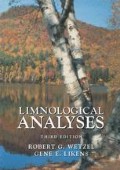Abstract
Most Zooplankton, and some benthic animals, reproduce continuously. As a population changes by addition and growth over a given time interval, a demographic turnover occurs [see reviews of Edmondson (1974) and Rigler and Downing (1984)]. Few, if any, of the individuals present at the peak of an exponentially developing population were alive at the beginning of the exponential phase. An individual also undergoes a biochemical turnover during its lifetime so that, upon completing a mean lifespan, it will have assimilated several times its final mass.
Production, in the context of a population, then, is growth and is only one factor in the material or energy budget for the whole population (Edmondson, 1974):
where P = production; C = consumption or feeding; F = egestion (feces and regurgitation); U = excretion; R = respiration; and G r = gametes.
Assimilation (A) is the difference between ingestion and egestion (A = C - F)
With continuous reproduction, the cohorts of the population overlap, so that it is either difficult or impossible to observe changes in abundance over time. To analyze the production of populations with continuous reproduction, it is necessary to use methods that do not require complete evaluation of cohort differences.
A number of models of Zooplankton production have been developed, but they fall into two general classes: (1) direct models based on time-dependent parameters of the zooplankton species [e.g., Edmondson and Winberg (1971) and Rigler and Downing (1984)], and (2) indirect models based on inferred rates of Zooplankton filtering, assimilation, and consumption by fish and other predators [e.g., Winberg (1971)]. Both discrete time-interval and instantaneous models are used to estimate production.
The change in numbers (N) in a population over a time (t) interval is given by:
The population at time t, then, is
Mortality includes both natural death and losses by predation.
Since it is necessary to measure recruitment or birth rate, and with continuous birth and death one cannot identify distinct cohorts, production (P) can be calculated from either the rate of growth (i.e., the duration) of different size classes or of life history stages (Edmondson, 1974):
where the subscripts 1,2,3 ... n = stages or size classes; w = the weight of the class; T = the duration of the stage, in days; and Δw = the weight increment of the class (birth + growth -mortality).
This relationship implies that, when a stage lasts two days, one-half of the individuals will pass from that stage on one day and the other half on the following day, i.e., the number of individuals in a given stage will be inversely proportional to the duration of that stage. It is assumed that the animals have a uniform age distribution, which is not always the case.
The objective of this exercise is to construct a realistic, logical model of Zooplankton production. The model then can be used to estimate the production of a sample Zooplankton species over a given time interval. By this means, the future population size of the species can be predicted on the basis of its present population structure and size, observed size-specific production of eggs, and certain assumed or known information on biomass and survival. This procedure will be demonstrated using Daphnia. For precise results, detailed information on birth, growth rates, and mortality would be required for each species under investigation.
Access this chapter
Tax calculation will be finalised at checkout
Purchases are for personal use only
Preview
Unable to display preview. Download preview PDF.
References
Edmondson, W.T. 1974. Secondary production. Mitt. Int. Ver. Limnol. 20:229–272.
Edmondson, W.T. and G.G. Winberg (eds). 1971. A Manual on Methods for the Assessment of Secondary Productivity in Fresh Waters. IBP Handbook 17. Blackwell, Oxford. 358 pp.
Haney, J.F. and D.J. Hall. 1973. Sugar-coated Daphnia: A preservation technique for Cladocera. Limnol. Oceanogr. 18:331–333.
Likens, G.E. and J.J. Gilbert. 1970. Notes on quantitative sampling of natural populations of planktonic rotifers. Limnol. Oceanogr. 15:816–820.
Prepas, E. 1978. Sugar-frosted Daphnia: An improved fixation technique for Cladocera. Limnol. Oceanogr. 23:557–559.
Rigler, F.H. and J. A. Downing. 1984. The calculation of secondary productivity, pp. 19–58. In:J.A. Downing, and F.H. Rigler, Editors. A Manual on Methods for the Assessment of Secondary Productivity in Fresh Waters. 2nd Ed. Blackwell, Oxford.
Winberg, G.G. (ed.) 1972. Methods for the Estimation of Production of Aquatic Animals. Academic Press, New York. 175 pp.
Author information
Authors and Affiliations
Rights and permissions
Copyright information
© 2000 Springer Science+Business Media New York
About this chapter
Cite this chapter
Wetzel, R.G., Likens, G.E. (2000). Zooplankton Production. In: Limnological Analyses. Springer, New York, NY. https://doi.org/10.1007/978-1-4757-3250-4_16
Download citation
DOI: https://doi.org/10.1007/978-1-4757-3250-4_16
Publisher Name: Springer, New York, NY
Print ISBN: 978-1-4419-3186-3
Online ISBN: 978-1-4757-3250-4
eBook Packages: Springer Book Archive

